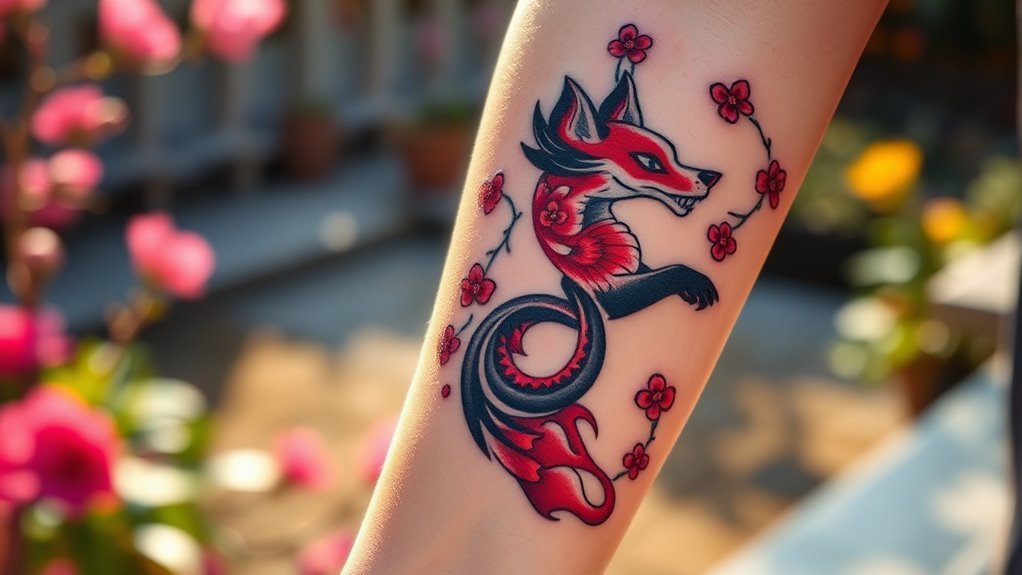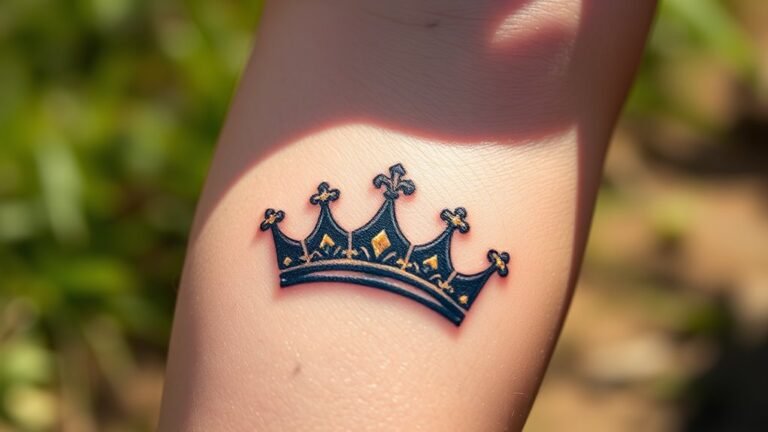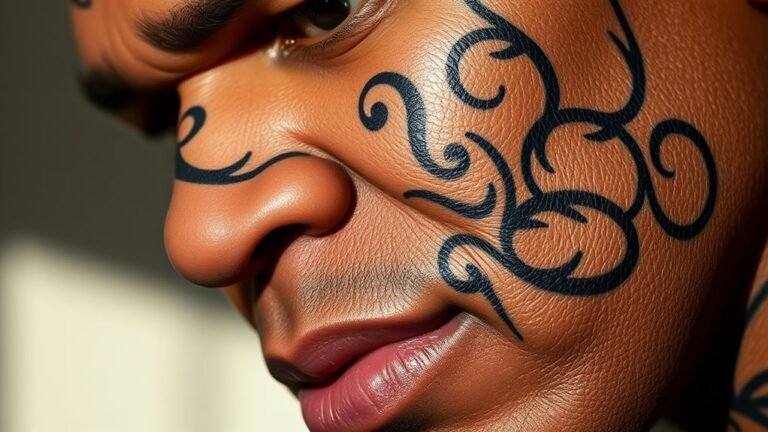Kitsune Tattoo Meaning and Symbolism
Kitsune tattoos offer a rich tapestry of meaning that intertwines with Japanese mythology and personal identity. As you explore their symbolism, consider how transformation and duality play pivotal roles in these designs. What do the number of tails signify, and how does this connect to the lore of Inari? Each choice in color and style can reflect your unique narrative. What does your story reveal about the multifaceted nature of your own journey?
In a Nutshell
- Kitsune tattoos symbolize transformation and duality, reflecting the complexities of human identity and personal growth.
- They serve as messengers of Inari, representing fertility, prosperity, and spiritual nourishment in Japanese culture.
- The color choices in Kitsune tattoos convey specific meanings, such as red for protection and black for mystery.
- Kitsune embody both benevolence and mischief, illustrating the balance of light and dark qualities in life.
- Different artistic styles, like traditional Japanese and abstract, allow for personal expression and cultural significance in Kitsune tattoos.
The Origin of Kitsune in Japanese Mythology
Kitsune, or foxes, have deep roots in Japanese mythology, where they're often depicted as mystical beings with transformative powers.
Understanding the kitsune origin reveals a tapestry of folklore that connects these creatures to both Shinto and Buddhist traditions. You'd find that the mythological significance of kitsune goes beyond mere animal representation; they embody the duality of benevolence and mischief, frequently serving as protectors or tricksters.
As you investigate further, consider how these narratives reflect societal values and fears. What can the evolution of kitsune tales tell you about the connection between humans and nature?
This inquiry invites you to explore how the kitsune's legacy has shaped cultural identity, intertwining history with modern interpretations that resonate with those seeking a sense of belonging.
Symbolism of Transformation and Duality
In Japanese folklore, the kitsune embodies profound symbolism tied to transformation and duality. You might find it intriguing how this mythical creature seamlessly shifts between forms, representing the transformation symbolism inherent in its nature.
The kitsune teaches that change isn't only inevitable but essential for growth and self-discovery.
Moreover, its duality representation highlights the coexistence of light and dark, revealing that every aspect of life holds both positive and negative qualities. This complexity invites you to embrace your multifaceted identity, reflecting your own journey of transformation.
As you explore kitsune tattoos, consider how they resonate with your personal narrative, celebrating the beautiful balance of contradictions that shape who you are.
The Connection to Inari: The Deity of Rice and Prosperity
While exploring the rich tapestry of Japanese mythology, you'll discover the significant connection between kitsune and Inari, the revered deity of rice and prosperity.
Inari worship often involves the veneration of kitsune as messengers, embodying the blessings of fertility and abundance. This relationship highlights rice symbolism, as rice is seen as a crucial sustenance and a marker of wealth in Japanese culture.
You might find it fascinating how kitsune, with their association with Inari, represent not just agricultural prosperity but also spiritual wealth.
As you investigate deeper, consider how this connection enriches your understanding of kitsune tattoos, transforming them into symbols of both material and spiritual nourishment, fostering a sense of belonging to a heritage that values abundance in all forms.
Kitsune as Protectors and Guides
As you explore the role of kitsune as protectors and guides, you'll find that their significance extends beyond mere folklore to embody a profound connection to safety and wisdom.
These mythical guardians are often viewed as spiritual guides, offering insight and direction in times of uncertainty.
Consider the following aspects of kitsune in this protective role:
- Cunning and Intelligence: They navigate challenges with sharp wit, teaching you the value of cleverness.
- Loyalty and Devotion: Their unwavering commitment underscores the importance of trust in relationships.
- Transformation and Adaptability: Kitsune embody change, encouraging you to embrace growth and evolution.
In this light, you'll see how kitsune serve as a reminder that guidance often comes from unexpected sources.
The Significance of the Number of Tails
Kitsune are often depicted with a varying number of tails, each representing different levels of power and wisdom. The tails' significance is deeply rooted in Japanese mythology, where a fox gains an additional tail for every hundred years it lives. This transformation symbolizes the accumulation of knowledge and spiritual growth.
You might wonder how this ties into your own life. Just as a multi-tailed kitsune embodies higher abilities and deeper understanding, your journey can reflect a quest for wisdom and strength.
The mythical representations of these creatures encourage you to explore your own potential, inviting you to seek connections with the spiritual world. How many tails do you envision for yourself as you navigate your path?
Color Meanings in Kitsune Tattoos
When choosing colors for a kitsune tattoo, it's essential to understand the cultural significance behind each hue. The color symbolism in these tattoos can deepen your connection to the art and its meaning.
Different colors can convey various attributes and emotions, impacting the overall design of your tattoo palette. Consider the following:
- Red: Represents protection and power, often associated with the divine.
- White: Symbolizes purity and innocence, reflecting the kitsune's mystical nature.
- Black: Signifies mystery and the unknown, also linking to transformation.
The Role of Kitsune in Folklore and Legends
In Japanese folklore, the kitsune embodies a complex duality that intrigues many. These mystical foxes are often viewed as benevolent protectors, guiding humans towards prosperity and wisdom.
Yet, kitsune legends also portray them as cunning tricksters, capable of deception and manipulation. This dual nature raises essential questions: What does it mean to trust something that can change its form? How do these tales reflect our own struggles with trust and betrayal?
As you investigate kitsune folklore, you might discover that these creatures symbolize the balance between light and dark, certainty and doubt.
This rich tapestry of stories invites you to explore your own beliefs, encouraging a deeper connection to the world around you. Embrace the duality; it may resonate more than you think.
Kitsune Tattoos in Modern Culture
As the fascination with Japanese culture grows globally, kitsune tattoos have emerged as an enchanting symbol in modern body art.
These tattoos reflect a blend of traditional kitsune symbolism and contemporary styles, creating a unique narrative for each individual. You might wonder how these tattoos resonate with today's society.
- They represent transformation and adaptability in an ever-changing world.
- Modern interpretations often highlight themes of empowerment and mystery.
- Kitsune tattoos also foster a sense of belonging, connecting wearers to a rich cultural heritage.
Personal Interpretations and Variations
While kitsune tattoos carry rich traditional meanings, their personal interpretations and variations can greatly differ among individuals. You might find that your tattoo reflects unique personal stories, shaped by your experiences and emotions.
Perhaps the kitsune symbolizes your transformation or resilience, resonating deeply with your journey. Cultural influences also play a pivotal role; for instance, someone with Japanese heritage might connect more closely to the folklore surrounding kitsune, while others may adopt the symbol as a representation of cleverness or intuition.
Your interpretation can intertwine these elements, creating a design that feels uniquely yours. Engaging with the symbolism allows you to explore not just the tattoo's meaning, but how it represents your identity and the connections you share with others.
Choosing the Right Kitsune Design for You
Finding the right kitsune design involves considering both the traditional symbolism and your personal narrative.
Reflect on what aspects resonate with you, as your tattoo should embody more than just aesthetics.
Think about your design preferences and how they connect to your life story.
- Symbolic elements: Do you want to highlight wisdom, transformation, or protection?
- Style: Are you drawn to realistic, abstract, or traditional Japanese art?
- Color palette: Will vibrant colors or monochrome better express your personality?
Frequently Asked Questions
Are There Any Specific Cultural Taboos Associated With Kitsune Tattoos?
When considering kitsune tattoos, you should explore their cultural significance. Understanding tattoo etiquette in related cultures is essential, as certain designs may carry specific meanings or taboos that could impact your connection to the art form.
How Do I Care for My Kitsune Tattoo?
To care for your tattoo, focus on proper tattoo maintenance. Use aftercare products like unscented lotion and avoid sun exposure. How does your skin respond? Adjust your routine based on your tattoo's healing process for best results.
Can Kitsune Tattoos Be Customized to Reflect Personal Beliefs?
Absolutely, you can customize your kitsune tattoo to reflect your personal beliefs. By incorporating unique designs and personal expressions, you create a meaningful piece that resonates with your identity and fosters a deeper connection to the artwork.
What Are Common Misconceptions About Kitsune Tattoos?
You might think kitsune tattoos only represent cunning or trickery, but they embrace deeper themes in kitsune folklore. Misconceptions often overlook their rich symbolism and diverse tattoo styles, which convey connection, protection, and transformation.
Are Kitsune Tattoos More Popular in Certain Regions or Cultures?
Kitsune tattoos often reflect regional variations in their symbolism, especially in Japan. You'll find these tattoos more popular in areas embracing Shinto beliefs, where their significance resonates deeply, creating a sense of belonging among enthusiasts.







